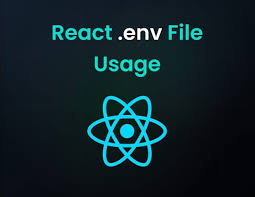Mastering .env File Usage in React Applications
 Raaj Aryan
Raaj Aryan
React, as a popular JavaScript library for building user interfaces, allows developers to create dynamic and responsive web applications. One crucial aspect of React development is managing environment variables, which can be effectively handled using the .env file. In this guide, we will delve deep into the usage of the .env file in React, covering its purpose, best practices, and real-world applications.
What is an .env File?
The .env file is a simple text file used to store environment variables, which are key-value pairs that configure the environment in which your application runs. Environment variables are used to separate configuration settings from your code, making your application more secure and easier to manage.
Why Use an .env File?
Security: Sensitive information such as API keys, database credentials, and secret tokens can be stored in the
.envfile, keeping them out of your source code.Configurability: Environment variables allow you to change the behavior of your application without modifying the codebase.
Portability: By using environment variables, you can easily switch between different environments (development, testing, production) with minimal configuration changes.
Setting Up an .env File in a React Project
To use environment variables in a React project, you need to follow these steps:
Step 1: Create the .env File
In the root directory of your React project, create a file named .env. This file will contain all your environment variables. For example:
REACT_APP_API_URL=https://api.example.com
REACT_APP_API_KEY=your_api_key_here
Step 2: Prefix Your Variables
React requires all environment variables to be prefixed with REACT_APP_. This prefix ensures that only the variables meant for React applications are included in the build.
Step 3: Accessing Environment Variables
To access the environment variables in your React application, use process.env.REACT_APP_VARIABLE_NAME. Here’s an example:
const apiUrl = process.env.REACT_APP_API_URL;
const apiKey = process.env.REACT_APP_API_KEY;
console.log("API URL:", apiUrl);
console.log("API Key:", apiKey);
Step 4: Using .env Variables in Your React App
You can use environment variables to configure various parts of your React application. For instance, you might use them to set the API endpoint URL or to enable/disable features based on the environment.
Step 5: Add .env to .gitignore
To ensure that your .env file is not committed to version control (e.g., GitHub), add it to your .gitignore file:
.env
This prevents sensitive information from being exposed in your repository.
Best Practices for Using .env Files
Limit Scope: Only include necessary variables in your
.envfile. Avoid storing large amounts of data or sensitive information that doesn’t need to be accessed by your application.Use Different Files for Different Environments: Create separate
.envfiles for different environments, such as.env.development,.env.production, and.env.test. This approach ensures that environment-specific configurations are isolated.Validate Variables: Validate the presence and correctness of your environment variables during the application startup to avoid runtime errors.
Document Variables: Keep a sample
.envfile (.env.example) with placeholder values to document the necessary environment variables for your project.
Real-World Applications of .env Files in React
Configuring API Endpoints
One common use case for environment variables is configuring API endpoints. Depending on the environment, your application might need to interact with different APIs. Here’s how you can achieve this using .env files:
// .env.development
REACT_APP_API_URL=https://dev-api.example.com
// .env.production
REACT_APP_API_URL=https://api.example.com
In your React code, you can access the API URL like this:
const apiUrl = process.env.REACT_APP_API_URL;
fetch(`${apiUrl}/data`)
.then(response => response.json())
.then(data => console.log(data))
.catch(error => console.error('Error:', error));
Enabling/Disabling Features
You can use environment variables to enable or disable features based on the environment. For example, you might want to enable debugging tools only in the development environment:
// .env.development
REACT_APP_ENABLE_DEBUG=true
// .env.production
REACT_APP_ENABLE_DEBUG=false
In your React code, you can conditionally enable features based on the environment variable:
if (process.env.REACT_APP_ENABLE_DEBUG === 'true') {
console.log('Debugging is enabled');
}
Configuring Third-Party Services
Many applications rely on third-party services like Google Analytics, Firebase, or Stripe. You can configure these services using environment variables to keep your credentials secure:
REACT_APP_GOOGLE_ANALYTICS_ID=your_google_analytics_id
REACT_APP_FIREBASE_API_KEY=your_firebase_api_key
REACT_APP_STRIPE_PUBLIC_KEY=your_stripe_public_key
In your React code, you can initialize these services using the environment variables:
const analyticsId = process.env.REACT_APP_GOOGLE_ANALYTICS_ID;
const firebaseApiKey = process.env.REACT_APP_FIREBASE_API_KEY;
const stripePublicKey = process.env.REACT_APP_STRIPE_PUBLIC_KEY;
// Initialize Google Analytics
ReactGA.initialize(analyticsId);
// Initialize Firebase
firebase.initializeApp({
apiKey: firebaseApiKey,
// Other Firebase config
});
// Initialize Stripe
const stripe = Stripe(stripePublicKey);
Advanced Usage of .env Files in React
Custom Environment Variables
While React enforces the REACT_APP_ prefix for environment variables, you might encounter scenarios where you need to use custom environment variables. This can be achieved by using tools like dotenv and cross-env.
Using dotenv
dotenv is a popular library for loading environment variables from a .env file into process.env. To use dotenv with React, you need to install it and create a custom script to configure the environment variables:
npm install dotenv
Create a config.js file to load the environment variables:
require('dotenv').config();
const webpack = require('webpack');
module.exports = function override(config) {
config.plugins = (config.plugins || []).concat([
new webpack.DefinePlugin({
'process.env': JSON.stringify(process.env),
}),
]);
return config;
};
In your package.json, add a custom script to run the configuration:
"scripts": {
"start": "node config.js && react-scripts start",
"build": "node config.js && react-scripts build",
"test": "node config.js && react-scripts test"
}
Using cross-env
cross-env is another tool that allows you to set environment variables across different platforms. It ensures that environment variables are set correctly regardless of the operating system.
To use cross-env, install it as a development dependency:
npm install cross-env --save-dev
Modify your package.json scripts to use cross-env:
"scripts": {
"start": "cross-env REACT_APP_API_URL=https://api.example.com react-scripts start",
"build": "cross-env REACT_APP_API_URL=https://api.example.com react-scripts build",
"test": "cross-env REACT_APP_API_URL=https://api.example.com react-scripts test"
}
Dynamic Environment Variables
In some cases, you might need to set environment variables dynamically at runtime. One approach is to use a server-side endpoint to fetch configuration settings. This method is particularly useful for sensitive information that should not be exposed in the client-side code.
Server-Side Configuration
Create a Server Endpoint: Set up an endpoint on your server to provide configuration settings.
Fetch Configuration: In your React application, fetch the configuration settings from the server and store them in the application state or a context provider.
Use Configuration: Access the configuration settings throughout your application as needed.
Here’s an example of fetching configuration settings from a server:
// server.js
const express = require('express');
const app = express();
app.get('/config', (req, res) => {
res.json({
apiUrl: process.env.API_URL,
apiKey: process.env.API_KEY,
});
});
app.listen(3001, () => {
console.log('Server is running on port 3001');
});
// App.js
import React, { useEffect, useState } from 'react';
function App() {
const [config, setConfig] = useState({});
useEffect(() => {
fetch('/config')
.then(response => response.json())
.then(data => setConfig(data))
.catch(error => console.error('Error fetching config:', error));
}, []);
return (
<div>
<h1>React App with Dynamic Environment Variables</h1>
<p>API URL: {config.apiUrl}</p>
<p>API Key: {config.apiKey}</p>
</div>
);
}
export default App;
Conclusion
Using the .env file in a React application is a powerful way to manage environment variables, making your application more secure, configurable, and portable. By following the best practices and real-world examples outlined in this guide, you can effectively utilize environment variables to enhance your React development workflow. Here are some key takeaways:
Security: Keep sensitive information out of your source code by using environment variables.
Configurability: Easily change the behavior of your application without modifying the codebase by leveraging different
.envfiles for different environments.Portability: Seamlessly switch between development, testing, and production environments by using environment-specific configuration files.
Best Practices: Validate, document, and limit the scope of your environment variables to ensure a robust and maintainable application.
Advanced Techniques: Use tools like
dotenvandcross-envfor custom environment variable management and fetch dynamic configuration settings at runtime when necessary.
By integrating these strategies into your React projects, you will be better equipped to handle various configuration challenges, resulting in more efficient and maintainable applications.
Further Reading and Resources
To further deepen your understanding and skills in managing environment variables in React, consider exploring the following resources:
React Documentation: The official React documentation provides comprehensive insights into various React features and best practices.
Dotenv Documentation: Learn more about the
dotenvpackage and how to use it for loading environment variables.Cross-env Documentation: Understand how
cross-envhelps in setting environment variables across different platforms.Securing API Keys: Explore strategies for securing API keys and other sensitive information in your frontend applications.
Web Security Best Practices: Delve into web security best practices to protect your applications from potential vulnerabilities.
By continuously learning and applying these best practices, you can enhance the security, flexibility, and maintainability of your React applications. Happy coding!
💰 You can help me by Donating
Subscribe to my newsletter
Read articles from Raaj Aryan directly inside your inbox. Subscribe to the newsletter, and don't miss out.
Written by

Raaj Aryan
Raaj Aryan
MERN Stack Developer • Open Source Contributor • DSA With Java • Freelancer • Youtuber • Problem-solving •
